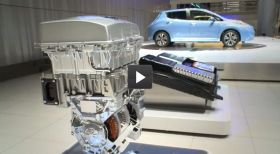
It’s a hard fact of life that while electric vehicles benefit the environment by producing zero tailpipe emissions, they can have an impact in other areas. Perhaps the most significant is the use of rare earth elements for the batteries and electric motors.
As one aspect of the Nissan Green Program 2016 – the company’s continuing commitment to the environment – is an undertaking to reduce the use of rare earth elements (REE) to minimise the depletion of natural resources.
For example, an engineering innovation has led to the development of a new electric motor that significantly cuts the use of dysprosium (Dy and carrying the atomic number 66). The new motor will be used in the updated Nissan LEAF – revealed in Japan in November – and in future EVs and hybrid electric vehicles (HEV).
Until now, dysprosium has covered the neodymium magnets used in electric motors to strengthen their heat resistance. But a breakthrough development arrived at jointly by Nissan and its suppliers now means it is no longer necessary to cover the entire magnet with the element.
How? This might sound complicated but it’s simpler than it first appears. The breakthrough has been the development of a grain boundary diffusion process which distributes the dysprosium around the microscopic gaps (the grain boundary) between the crystal structures which make up the magnet.
This improves the magnet’s heat resistance and maintains high performance levels, yet reduces the amount of dysprosium by as much as 40 per cent when compared to a conventional electric motor.
Dysprosium is exceptionally rare and not found as a free element but has to be extracted from various minerals, which are currently mostly found in southern China. Its name comes from the Greek dysprositos which fittingly means ‘hard to get’. The rise in demand for electric vehicles and clean energy home appliances means demand for dysprosium is also increasing. With this new diffusion process, Nissan is not just reducing its exposure to a dwindling rare resource but also cutting its costs.
This is just the first step in the process to limit use of rare earth elements. Eventually Nissan aims to use no dysprosium at all in other components such as electric power steering systems or speakers. The company is also committed to reducing other REE such as cerium (Ce) and lanthanum (La) currently used in catalytic exhaust components and in cast iron.
print Tweet
